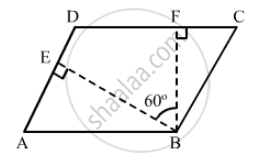Advertisements
Advertisements
प्रश्न
In Fig. 17.29, suppose it is known that DE = DF. Then, is ΔABC isosceles? Why or why not?
उत्तर
\[\text{ In } ∆ FDE: \]
\[DE = DF \]
\[ \therefore \angle FED = \angle DFE . . . . . . . . . . . . . (i) (\text{ angles opposite to equal sides })\]
\[\text{ In the } {II}^{gm} BDEF: \]
\[\angle FBD = \angle FED . . . . . . . (ii) (\text{ opposite angles of a parallelogram are equal })\]
\[\text{ In the } {II}^{gm} DCEF: \]
\[\angle DCE = \angle DFE . . . . . . (iii) (\text{ opposite angles of a parallelogram are equal })\]
\[\text{ From equations } (i), (ii) \text{ and } (iii): \]
\[\angle FBD = \angle DCE\]
\[\text{ In } \bigtriangleup ABC: \]
\[If \angle FBD = \angle DCE, \text{ then } AB = AC (\text{ sides opposite to equal angles }) . \]
\[\text{ Hence }, \bigtriangleup ABC \text{ is isosceles }.\]
APPEARS IN
संबंधित प्रश्न
The angle between the altitudes of a parallelogram, through the same vertex of an obtuse angle of the parallelogram is 60°. Find the angles of the parallelogram.

Which of the following statement is true for a rectangle?
Its diagonals are equal and perpendicular, and bisect each other.
Diagonals of a rectangle ABCD intersect at point O. If AC = 8 cm then find BO and if ∠CAD =35° then find ∠ACB.
A quadrilateral whose opposite sides and all the angles are equal is a ______.
If the diagonals of a quadrilateral are equal and bisect each other, then the quadrilateral is a ______.
If diagonals of a quadrilateral are equal, it must be a rectangle.
Every parallelogram is a rectangle.
Every rectangle is a trapezium.
PQRS is a rectangle. The perpendicular ST from S on PR divides ∠S in the ratio 2:3. Find ∠TPQ.
Construct a rectangle whose one side is 3 cm and a diagonal equal to 5 cm.
